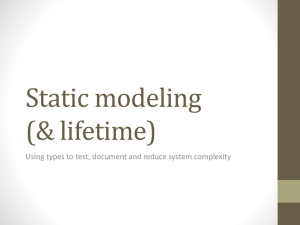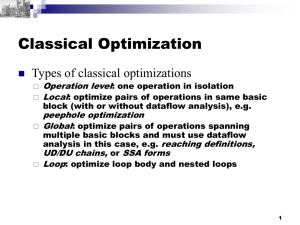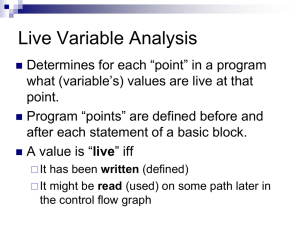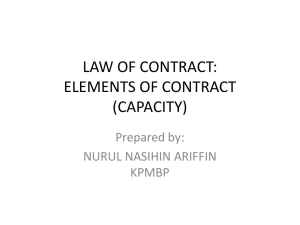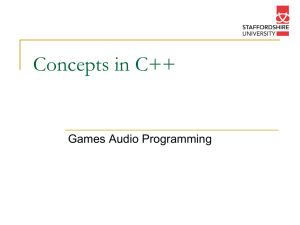qdp++ - JLab Computer Center
advertisement
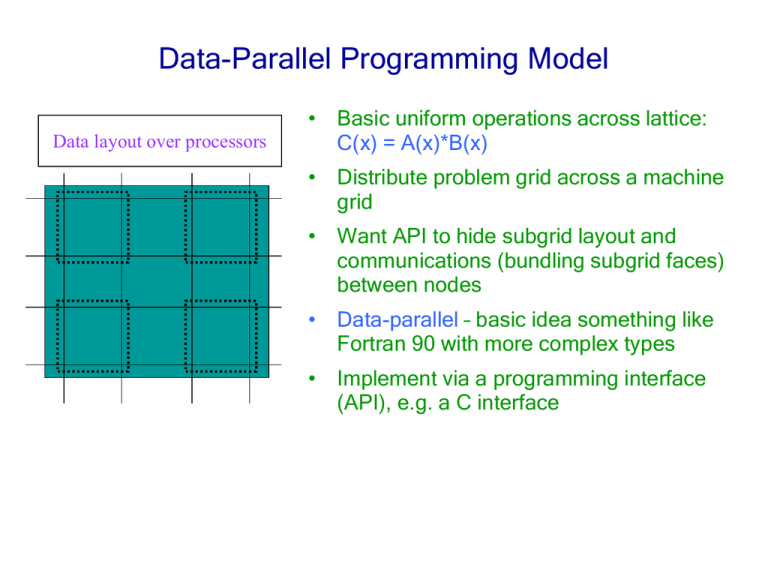
Data-Parallel Programming Model
Data layout over processors
• Basic uniform operations across lattice:
C(x) = A(x)*B(x)
• Distribute problem grid across a machine
grid
• Want API to hide subgrid layout and
communications (bundling subgrid faces)
between nodes
• Data-parallel – basic idea something like
Fortran 90 with more complex types
• Implement via a programming interface
(API), e.g. a C interface
QCD Data Types
• Fields have various types (indices):
Color: U i j x , Spin: ,
i x ,
ij
Q
x
• Lattice Fields or scalar (same on all sites)
• Index type (at a site)
•
•
•
•
Gauge fields:
Fermions:
Scalars:
Propagators:
Product(Matrix(Nc),Scalar)
Product(Vector(Nc),Vector(Ns))
Scalar
Product(Matrix(Nc),Matrix(Ns))
• Support compatible operations on types:
U ij x * *i x
Matrix(color)*Matrix(spin)*Vector(color,spin)
QCD-API
Level 3
Dirac Operators, CG Routines etc.
C, C++, etc.
(Organized by high level codes etc.)
Level 2
Data Parallel QCD Lattice Operations
(overlapping Algebra and Messaging)
A = SHIFT(B, mu) * C; Global sums, etc
Lattice Wide Lin Alg
Lattice Wide Data Movement
(No Communication)
(Blocking Communication)
e.g. A = B * C
I/O
(XML)
Serialization/
Marshalling
e.g Atemp = SHIFT(A, mu)
Level 1
QLA: Linear Algebra API
QMP: Message Passing API
SU(3), gamma algebra etc.
Communications
Level 2 Functionality
Object types/declarations:
LatticeGaugeF, ReadF, ComplexF, …
Unary operations:
operate on one source and return (or into) a target
void Shift(LatticeGaugeF target, LatticeGaugeF source, int sign, int direction, Subset s);
void Copy(LatticeFermionF dest, LatticeFermionF source, Subset s);
void Trace(LatticeComplexF dest, LatticeGaugeF source, Subset s);
Binary operations: operate on two sources and return into a target
void Multiply(LatticePropagatorF dest, LatticePropagatorF src1, LatticeGaugeF src2, Subset s);
void Gt(LatticeBooleanF dest, LatticeRealF src1, LatticeRealF src2, Subset s);
Broadcasts:
broadcast throughout lattice
void Fill(LatticeGaugeF dest, RealF val , Subset s);
Reductions:
reduce through the lattice
void Norm2(RealD dest, LatticeFermionF source, Subset s);
C Interface for Level 2
Binary:
Multiplication has many varieties
void QDP_F_T3_eqop_T1op1_mult_T2op2 (restrict Type3 *r, Type1 *a, Type2
*b, const Subset s)
Multiply operations where T1, T2, T3 are shortened type names for the types
Type1, Type2 and Type3
LatticeGaugeF, LatticeDiracFermionF, LatticeHalfFermionF, LatticePropagatorF,
ComplexF, LatticeComplexF, RealF, LatticeRealF, …
and eqop,op1,op2 considered as a whole imply operations like
eq,,
r = a*b
eqm,,
r = -a*b
eq,,A
r = a*conj(b)
eqm,,A r = -a*conj(b)
eq,A,
r = conj(a)*b
eqm,A, r = -conj(a)*b
eq,A,A r = conj(a)*conj(b)
eqm,A,A r = -conj(a)*conj(b)
peq,,
r = r + a*b
meq,,
r = r – a*b
peq,,A r = r + a*conj(b)
meq,,A r = r – a*conj(b)
peq,A, r = r + conj(a)*b
meq,A, r = r – conj(a)*b
peq,A,A r = r + conj(a)*conj(b)
meq,A,A r = r - conj(a)*conj(b)
QDP++
• Why C++ ?
– Many OOP’s benefits:
•
•
•
•
•
•
Simplify naming with operator overloading
Strong type checking – hard to call wrong routine
Can create expressions!
Closures straightforward - return types easily
Can straightforwardly automate memory allocation/destruction
Good support tools (e.g., doxygen – documentation generator)
– Maintenance:
• Generate large numbers of variant routines via templates
• Contrary to popular opinion, there are compilers that meet
standards. Minimum level is GNU g++. Expect to use full 3.0
standards
• Simple to replace crucial sections (instantiations) with
optimized code
• Initial tests – g++ generating decent assembly!
– User acceptance:
• Language in common use
Flavors
Operation syntax comes in two variants:
Global functional form (optimization straightforward):
void Multiply_replace(Type3& dest, const Type1& src1, const Type2&
src2);
Operator form (optimizations require delayed evaluation):
Type3 operator*(const Type1& src1, const Type2& src2);
void operator=(Type3& dest, const Type3& src1);
Were the types Type1, Type2 and Type3 are the names again
LatticeGaugeF, LatticeDiracFermionF, …
Declarations:
Objects declared and allocated across the lattice (not initialized)
LatticeGaugeF a, b;
Templates for Operations
Without templates, multiple overloaded declarations required:
void Multiply_op3(LatticeComplexF& dest, const RealF& src1, const LatticeComplexF& src2);
void Multiply_op3(LatticeDiracFermionF& dest, const LatticeGaugeF& src1, const
LatticeDiracFermionF& src2);
Can merge similar operations with templates:
template<class T3, class T1, class T2> void Multiply_op3(T3& dest, const T1& src1, const
T2& src2);
Optimizations easily provided via specializations:
template<class LatticeDiracFermionF, class LatticeGaugeF, class LatticeDiracFermionF>
void Multiply_op3(LatticeDiracFermionF& dest, const LatticeGaugeF& src1, const
LatticeDiracFermionF& src2) {/* Call your favorite QLA or QDP routine here */}
Templates for Declarations
Expect to have data driven (and not method driven) class types:
class LatticeDiracFermionF {
private:
DiracFermionF sites[layout.Volume()];
};
With templates:
template<class T> class Lattice {
private:
T sites[layout.Volume()];
};
typedef Lattice<DiracFermionF> LatticeDiracFermionF;
Type composition:
The fiber (site) types can themselves be made from templates
(implementation choice)
Implementation Example
Operator
syntax
Functional
syntax
QDP object syntax
QLA – optimized
linear algebra
routines
QMP – message
passing /
communications
• Use a container class to hold
info on object
• Easily separate functional and
operator syntatic forms
• Closures implemented at this
container level
• Underlying object class does
real work
• No additional overhead – use
inlining
// Functional form
inline void Multiply_replace(QDP<Type3>& dest, const QDP<Type1>& src1, const
QDP<Type2>& src2)
{ dest.obj().mult_rep(src1.obj(), src2.obj()); }
// Operator form without closure optimizations
inline QDP<Type3> operator*(const QDP<Type1>& src1, const QDP<Type2>& src2)
{QDP<Type3> tmp;
tmp.obj().mult_rep(src1.obj(), src2.obj());
return tmp;}
Example
// Declarations and construction – no default initialization
LatticeGaugeF u, tmp0, tmp1;
// Initialization
Gaussian(u);
Zero(tmp0);
tmp1 = 1.0;
// Two equivalent examples
Multiply_replace(tmp0, u, tmp1);
tmp0 = u * tmp1;
// Three equivalent examples
Multiply_conj2_ shift2_ replace(tmp1, u, tmp0, FORWARD, mu);
Multiply_replace(tmp1, u, Conj(Shift(tmp0,FORWARD,mu)));
tmp1 = u * Conj(Shift(tmp0,FORWARD,mu));
{
}
// Change default subset as a side-effect of a context declaration
Context foo(Even_subset);
tmp1 = u * Conj(Shift(tmp0,FORWARD,mu)); // Only on even subset
// Context popped on destruction
SZIN
• SZIN and the Art of Software Maintenance
–
–
–
–
–
–
–
–
–
–
M4 preprocessed object-oriented data-parallel programming interface
Base code is C
High level code implemented over architectural dependent level 2 layer
Supports scalar nodes, multi-process SMP, multi-threaded SMP, vector,
CM-2, CM-5, clusters of SMP’s
The Level 2 routines are generated at M4 time into a repository
Supports overlapping communications/computations
No exposed Level 1 layer
Can/does use (transparent to user) any external Level 1 or 2 routines
Optimized Level 3 routines (Dirac operator) available
Code publicly available by tar and CVS with many contributors – no
instances of separate code camps
• Data parallel interface
– SZIN is really the data-parallel interface and not the high level code
– Some projects have only used the low level code and library
– Could easily produce a standalone C implementation of the Level 2 API
Problems with SZIN
Why change current system? Cons:
– Maintenance:
• M4 has no scope. Preprocessor run over a file - no knowledge of C
syntax or scope – bizarre errors can result
• M4 has no programming support for holding type info. Must invent it
• Interface problem – awkward to hook onto level 1 like optimizations
– Extensibility:
• Problems with C – awkward to write generic algorithms, e.g. CG for
different Dirac operators (like Clover requiring sigma.F but not
Wilson), or algorithms on lattices or just single sites.
• No real language support for closures
• C very limited on type checking
• No automated memory allocation/free-ing. No simple way to write
expressions.
– User acceptance:
• M4 not familiar (and limited) to most users
Current Development Efforts
• QDP++ development
–
–
–
–
Level-2 C/C++ API not yet finalized by SciDAC – documentation underway
Currently testing the basic object model code needed for the single node version
Shortly start the parallel version – uses object model code
Will incorporate QLA library routines once agreed upon by SciDAC
• Stand-alone demonstration/prototyping suite
– Some test routines and drivers for physics routines live in the QDP++ test
directory
– David/Richard/Andrew/others writing some simple stand-alone routines (like
pure gauge) as a prototyping effort
– Expect to produce a user’s guide
• SZIN port
– Porting existing SZIN code with merging of MIT and Maryland code bases
– The M4 architectural support part is completely removed and only uses QDP
– Will become another high level code base using implementation dependent QDP
Hardware Acquisitions
• FY02
– NOW: 128 single processor P4, 2Ghz, Myrinet
• Expect ~ 130 Gflops
– Late summer: probably 256 single processor P4, 2Ghz, 3-dimensional
Gigabit-ethernet
• Expect 200 Gflops
• FY03
– Late summer: probably 256 single processor P4, 2.4Ghz, 3-dimensional
Gigabit-ethernet
• Expect 240 Gflops
